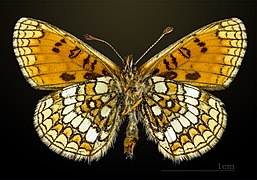Melitaea varia
- Machine translation, like DeepL or Google Translate, is a useful starting point for translations, but translators must revise errors as necessary and confirm that the translation is accurate, rather than simply copy-pasting machine-translated text into the English Wikipedia.
- Consider adding a topic to this template: there are already 1,848 articles in the main category, and specifying
|topic=will aid in categorization. - Do not translate text that appears unreliable or low-quality. If possible, verify the text with references provided in the foreign-language article.
- You must provide copyright attribution in the edit summary accompanying your translation by providing an interlanguage link to the source of your translation. A model attribution edit summary is
Content in this edit is translated from the existing German Wikipedia article at [[:de:Bündner Scheckenfalter]]; see its history for attribution. - You may also add the template
{{Translated|de|Bündner Scheckenfalter}}to the talk page. - For more guidance, see Wikipedia:Translation.
| Melitaea varia | |
|---|---|
 | |
| Scientific classification | |
| Domain: | Eukaryota |
| Kingdom: | Animalia |
| Phylum: | Arthropoda |
| Class: | Insecta |
| Order: | Lepidoptera |
| Family: | Nymphalidae |
| Genus: | Melitaea |
| Species: | M. varia |
| Binomial name | |
| Melitaea varia (Meyer-Dür, 1851)[verification needed] | |
Melitaea varia, the Grisons fritillary, is a butterfly of the family Nymphalidae. It is found in the Alps at heights of 1,500–2,600 m (4,900–8,500 ft), especially in the Swiss cantons Valais, Engadin and Graubünden. It is also found in the Ortler region in South Tyrol, Alpes-Maritimes and Drôme in France, high areas of Tirol in Austria and high areas in the Apennine Mountains such as Abruzzo.
Description
The wingspan is 24–28 mm.
Description from Seitz
varia Meyer-Dür (65b) is a smaller form from the higher Alps, recognizable by the markings on the hindwing beneath, which are pale yellow in the nymotypical form, being silvery white. In the male the markings in the median area of the forewing are usually somewhat obsolescent, the network formed by the veins and transverse lines being interrupted or paler before the apex. The female often shaded with blackish, the ground-colour having a tint of brass-colour or olive; the abdomen very heavy.[1]
Similar species
- Melitaea parthenoides. This species is larger, with a more distinct trellis pattern, and has fox-red palpi that are usually dark brown in varia . In addition, it flies in low-lying regions, so that there is hardly any overlapping of the flight area.
-
 Male
Male -
 Male underside
Male underside -
 Female
Female -
 Female underside
Female underside
Biology
There is one generation per year. The butterfly flies from June to August depending on the location. The larvae feed on various low-growing plants, including Plantago alpina, Gentiana verna and Gentiana acaulis.
References
- ^ Seitz. A. in Seitz, A. ed. Band 1: Abt. 1, Die Großschmetterlinge des palaearktischen Faunengebietes, Die palaearktischen Tagfalter, 1909, 379 Seiten, mit 89 kolorierten Tafeln (3470 Figuren)
 This article incorporates text from this source, which is in the public domain.
This article incorporates text from this source, which is in the public domain.
External links

- www.lepiforum.eu - Photos
- pyrgus.de
- "Melitaea Fabricius, 1807" at Markku Savela's Lepidoptera and Some Other Life Forms
- Fauna Europaea
- v
- t
- e














